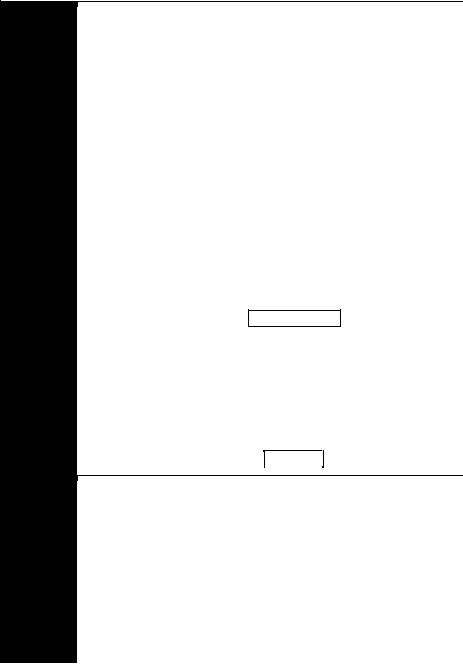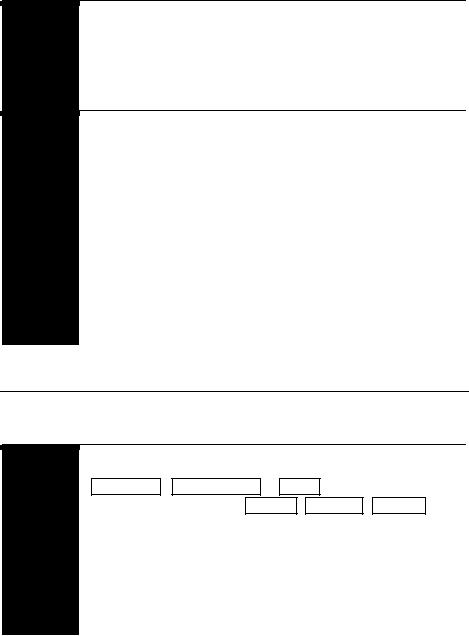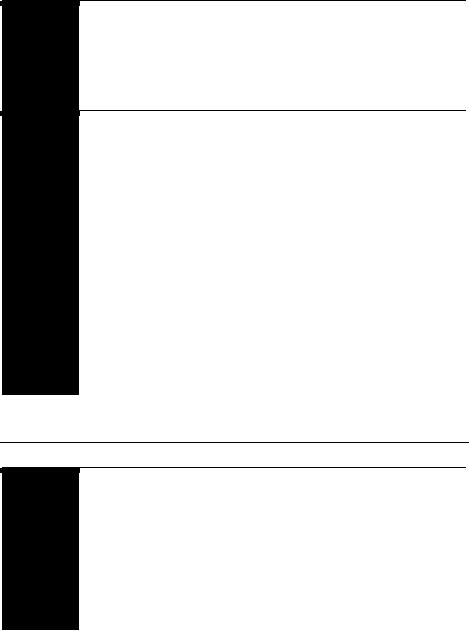
LAW / Referencing for Law Students / AGLC 3rd ed
.pdf
150 Part IV — International Materials
9.2.3Phase
Rule
Examples
The phase should be italicised and appear in parentheses (after the parties’ names). It should be included as it appears on the first or second page of the report, in accordance with chapter 1. However:
•any date in the phase should be omitted;
•where the phase is an order with respect to ‘provisional’ or ‘interim measures of protection’ or similar matters, the phase should appear as ‘(Provisional Measures)’;
•where the phase is an order or judgment with respect to ‘preliminary objections’ or similar matters, the phase should appear as ‘(Preliminary Objection)’ or ‘(Preliminary Objections)’ as appropriate; and
•where the phase is expressed as ‘Jurisdiction of the Court’, it should appear as ‘(Jurisdiction)’.
For procedural orders of the court on a particular matter, the phase should be included in the following form:
(Order on Name of Matter )
The name of the matter should appear as it does on the first page of the case. The name of the subject matter of the application, and not the date of the order, should be used (for example, ‘(Order on Application by Malta for Permission to Intervene)’). However, where the date is the only description of the order on the first page of the case, the phase should be included in the following form:
(Order of Full Date )
United States Diplomatic and Consular Staff in Tehran (United States of America v Iran) (Provisional Measures) [1979] ICJ Rep 7, 12 [10]–[11]. [Not: … (Request for the Indication of Provisional Measures) [1979] …]
South West Africa (Ethiopia v South Africa) (Preliminary Objections)
[1962] ICJ Rep 319, 378. [Not: … (Ethiopia v South Africa) (Judgment of 21 December 1962) …]
Fisheries Jurisdiction (United Kingdom of Great Britain and Northern Ireland v Iceland) (Jurisdiction) [1973] ICJ Rep 3.

Australian Guide to Legal Citation 151
Right of Passage over Indian Territory (Portugal v India) (Merits)
[1960] ICJ Rep 6.
Asylum (Colombia v Peru) (Judgment) [1950] ICJ Rep 266.
Nottebohm (Liechtenstein v Guatemala) (Second Phase) [1955] ICJ
Rep 4.
Nuclear Tests (New Zealand v France) (Order on Application by Fiji for Permission to Intervene) [1973] ICJ Rep 324. [Not: … (Order of 12 July 1973 — Application by Fiji for Permission to Intervene) …]
But: Nuclear Tests (New Zealand v France) (Order of 6 September 1973) [1973] ICJ Rep 341.
Note Cases before the ICJ and PCIJ may involve a number of separate decisions of the court. The ‘phase’ is the broad characterisation of the stage of the decision cited in the course of a case. The most common phases are:
•‘(Provisional Measures)’;
•‘(Preliminary Objections)’;
•‘(Jurisdiction)’;
•‘(Merits)’; and
•‘(Judgment)’.
A phase should always be included in a contentious case. Where there are not multiple phases in a particular contentious case, the phase ‘(Judgment)’ will usually be appropriate.
9.2.4Year
Rule The year of the volume of the report series in which the case appears should be included (after the phase) in square brackets.
Examples Certain German Interests in Polish Upper Silesia (Germany v Poland) (Judgment) [1925] PCIJ (ser A) No 6.
LaGrand (Germany v United States of America) (Judgment) [2001] ICJ Rep 466.
and ICJ
PCIJ

152 Part IV — International Materials
Note The official report series of both the ICJ and PCIJ are organised by year. The year therefore appears in square brackets (in accordance with rule 2.2).
9.2.5Report Series and Series Letter
Rule The report series abbreviation should appear (unitalicised) after the year.
For decisions of the PCIJ, the letter of the series (‘A’, ‘B’ or ‘A/B’) should also be included in the form:
(ser Letter of Series ) (for example, ‘(ser B)’).
Examples Oil Platforms (Islamic Republic of Iran v United States of America) (Preliminary Objection) [1996] ICJ Rep 803.
SS ‘Lotus’ (France v Turkey) (Judgment) [1927] PCIJ (ser A) No 10.
Note The ICJ publishes its decisions in Reports of Judgments, Advisory Opinions and Orders (abbreviated ‘ICJ Rep’).
The PCIJ published its decisions in series A, series B and series A/B of Publications of the Permanent Court of International Justice
(abbreviated ‘PCIJ’).
9.2.6Starting Page and Case Number
|
|
Rule |
|
For decisions of the ICJ, the starting page should be included after the |
|
|
|
|
report series abbreviation. |
|
|
|
|
For decisions of the PCIJ, the case number should be included |
|
|
|
|
(instead of a starting page) after the series. |
|
|
|
|
|
|
|
Examples |
|
Frontier Dispute (Benin v Niger) (Judgment) [2005] ICJ Rep 90. |
|
|
|
|
Factory at Chorzów (Germany v Poland) (Merits) [1928] PCIJ (ser A) |
|
|
|
|
No 17. |
|
|
|
|
|

Australian Guide to Legal Citation 153
Notes For decisions of the ICJ, the starting page is generally that on which the judgment begins. The page numbers of title page and the page containing information about mode of citation should not be used as the starting page. (However, the information on mode of citation indicates the correct starting page in its suggested citation to the decision.)
Decisions of the PCIJ were assigned a sequential number by the Court (for example, ‘No 3’). This number should be used to cite PCIJ decisions because the page numbering of each decision (even within a series) is non-consecutive (see rule 4.4 on non-consecutive pagination).
9.2.7Pinpoint References
Rule Pinpoint references should adhere to rules 1.1.5–1.1.6 and 2.5. In particular:
•where the pinpoint reference is to the first page of the report, the page number should be repeated;
•a series of pinpoint references should be separated by commas rather than ‘and’;
•where cases are paginated, pinpoint references should be to pages; and
•where a report has both page numbers and paragraph numbers, page numbers should always be included in a pinpoint reference and paragraph numbers may be included in addition.
Examples Railway Traffic between Lithuania and Poland (Advisory Opinion)
[1931] PCIJ (ser A/B) No 42, 109.
Barcelona Traction, Light and Power Company Ltd (Belgium v Spain) (Judgment) [1970] ICJ Rep 3, 5, 9, 10–11.
Corfu Channel (United Kingdom v Albania) (Preliminary Objection)
[1948] ICJ Rep 15, 26–7.
Certain Property (Liechtenstein v Germany) (Judgment) [2005] ICJ Rep 6, 19 [26], 20 [31]–[32], 21–5 [34]–[45].
and ICJ
PCIJ

154 Part IV — International Materials
9.2.8Identifying Judges
Rule Where a judgment of the court is referred to, neither a judge’s name nor ‘(The Court)’ should be included.
Where a separate or dissenting opinion or a declaration is referred to, the name(s) of the relevant judge(s) (if not otherwise apparent) may be included in parentheses after the pinpoint reference. Judges’ names should appear in accordance with rules 1.14.4 and 2.9.1, except that ‘Judge(s)’, ‘President’ and ‘Vice-President’ should be written out in full before judges’ surnames. ‘Separate Opinion’, ‘Dissenting Opinion’ and ‘Declaration’ (and any abbreviations of these terms) should not be included with judges’ names.
Examples
Note
Avena and Other Mexican Nationals (Mexico v United States of America) (Judgment) [2004] ICJ Rep 12, 79 (Judge Vereshchetin).
Interhandel (Switzerland v United States of America) (Preliminary Objections) [1959] ICJ Rep 6, 78 (President Klaestad).
Arrest Warrant of 11 April 2000 (Democratic Republic of the Congo v Belgium) (Judgment) [2002] ICJ Rep 3, 63–4 [2]–[3] (Judges Higgins, Kooijmans and Buergenthal).
Elettronica Sicula SpA (ELSI) (United States of America v Italy) (Judgment) [1989] ICJ Rep 15, 98 (Judge Schwebel). [Not: … (Dissenting Opinion of Judge Schwebel). nor … (Dis Op Judge Schwebel). nor … (DO Judge Schwebel).]
Where it is important that a judge made a declaration or gave a separate or dissenting opinion, this should be made clear in the text.
9.3Pleadings and Other Documents Originating in ICJ and PCIJ Proceedings
Rule Pleadings and other material of parties and of the court originating in proceedings before the ICJ should be cited as follows:

Australian Guide to Legal Citation 155
‘ Document Title ’, Case Name ( Parties’ Names )
[ Year ] ICJ Pleadings Starting Page , Pinpoint
( Speaker’s Name ).
Pleadings and other material of parties and of the court originating in proceedings before the PCIJ should be cited as follows:
‘ |
Document Title |
’, |
Case Name |
|
( |
Parties’ Names |
) [ |
Year |
] |
|||||||
|
PCIJ (ser C) No |
|
|
, |
|
|
|
, |
|
|
||||||
|
Number |
|
Starting Page |
Pinpoint |
||||||||||||
|
|
|
( |
|
). |
|||||||||||
|
|
|
Speaker’s Name |
|||||||||||||
The title of the document should appear as it does in the source, subject to chapter 1. Case names and parties’ names should adhere to rules 9.2.1–9.2.2. The year should be that of the volume cited. If the title page of a volume does not include a year, the year should be that of the decision (in the phase) to which the volume relates. Pinpoint references should adhere to rule 9.2.7, but should be to page numbers.
A speaker’s name (if not otherwise apparent) may be included after a pinpoint reference. Judges’ names should adhere to rule 9.2.8. Names of counsel, witnesses and other persons should adhere to rules 1.14 and 2.9.3.
For ICJ Pleadings, where more than one volume is published for a case, the volume number should precede ‘ICJ Pleadings’. It should appear in Roman numerals (for example, ‘[1985] II ICJ Pleadings’).
For PCIJ (ser C), the ‘number’ and the starting page of the document should be included (for example, ‘No 76, 12’). Where there are multiple parts within a ‘number’, the part should follow the number, preceded by ‘pt’. The part should appear in Roman numerals (for example, ‘No 17 pt II’).
Examples ‘Written Statement of the Government of the Kingdom of Denmark’,
Certain Expenses of the United Nations (Advisory Opinion) [1962] ICJ Pleadings 137.
‘Questions Put to Professor Glennon by Judge Schwebel’, Military and Paramilitary Activities in and against Nicaragua (Nicaragua v United States of America) [1986] V ICJ Pleadings 78, 78 (Judge Schwebel), 79 (Professor Glennon).
and ICJ
PCIJ

156 Part IV — International Materials
Notes
‘Memorial Filed by the Government of His Britannic Majesty’, Treaty of Lausanne, Article 3, Paragraph 2 (Advisory Opinion) [1925] PCIJ (ser C) No 10, 198, 200–3.
‘Speech by Dr Budding’, Rights of Minorities in Upper Silesia (Germany v Poland) [1928] PCIJ (ser C) No 14 pt II, 20, 25–7.
The ICJ publishes Pleadings, Oral Arguments, Documents
(abbreviated ‘ICJ Pleadings’), which contains documents and transmissions of the parties and the Court (such as the application instituting proceedings, submissions, minutes of oral argument and evidence). The ICJ Pleadings series is organised by case, then volume number.
The PCIJ published similar documents in series C of Publications of the Permanent Court of International Justice (abbreviated ‘PCIJ’). PCIJ (ser C) is organised by ‘numbers’ (for example, ‘No 2’). A ‘number’ sometimes contains multiple ‘parts’. Each ‘part’ is separately paginated and contains documents relating to a separate case.
9.4Unreported Materials
9.4.1Decisions
Rule |
Decisions of the ICJ that are not reported should be cited as follows: |
|
|
Case Name ( Parties’ Names ) ( Phase ) (International Court of Justice, General List No Number , Full Date ) Pinpoint .
Case names and parties’ names should adhere to rules 9.2.1–9.2.2. The general list number should be included as it appears on the page on which the judgment commences. The full date is that of the judgment. Pinpoint references should be to paragraphs (and should adhere to rules 1.1.5–1.1.6). Judges’ names may be included after pinpoints in accordance with rule 9.2.8.

Australian Guide to Legal Citation 157
Examples Certain Questions of Mutual Assistance in Criminal Matters (Djibouti v France) (Judgment) (International Court of Justice, General List No 136, 4 June 2008).
Dispute regarding Navigational and Related Rights (Costa Rica v Nicaragua) (Judgment) (International Court of Justice, General List No 133, 13 July 2009) [34].
Sovereignty over Pedra Branca/Pulau Batu Puteh, Middle Rocks and South Ledge (Malaysia v Singapore) (Judgment) (International Court of Justice, General List No 130, 23 May 2008) [8] (Judge ParraAranguren).
Notes Paragraph numbering generally begins afresh in a separate or dissenting opinion. Paragraph references to a separate or dissenting opinion are therefore to paragraphs within the opinion. A judge’s name must therefore be included in such references.
Decisions, pleadings and other material of the ICJ and PCIJ are available from the ICJ’s website at <http://www.icj-cij.org/>. There is no need to include a URL (to the ICJ’s website or otherwise) after a citation to unreported ICJ decisions or other material.
9.4.2Pleadings and Other Documents
Rule |
Pleadings and other material of parties and of the court originating in |
|||||||||||
|
proceedings before the ICJ that are not reported should be cited as |
|||||||||||
|
follows: |
|
|
|
|
|
|
|
|
|||
|
‘ |
|
’, |
|
( |
|
|
|
), International |
|||
|
Document Title |
Case Name |
Parties’ Names |
|||||||||
|
Court of Justice, General List No |
|
, |
|
, |
|
. |
|||||
|
Number |
Full Date |
Pinpoint |
|||||||||
The title of the document should appear as it does in the source, subject to chapter 1. Case names and parties’ names should adhere to rules 9.2.1–9.2.2. The general list number should be included as it appears on the page on which the judgment commences. The full date is that of the document cited.
Pinpoint references should adhere to rules 1.1.5–1.1.6 and should be to paragraph numbers where available (and where these are continuous across an entire document). Where a document has only
and ICJ
PCIJ

158 Part IV — International Materials
page numbers, pinpoints should be to page numbers. Pinpoint references to verbatim proceedings (and other transcripts) should be to page numbers.
Speakers’ names may be included after pinpoint references and should adhere to rule 9.3.
Examples ‘Application Instituting Proceedings’, Aerial Herbicide Spraying (Ecuador v Colombia), International Court of Justice, General List No 138, 31 March 2008, 28 [41].
‘Request for the Indication of Provisional Measures Submitted by the Government of the Kingdom of Belgium’, Questions Relating to the Obligation to Prosecute or Extradite (Belgium v Senegal), International Court of Justice, General List No 144, 17 February 2009, 2.
‘Memorial Submitted by Romania’, Maritime Delimitation in the Black Sea (Romania v Ukraine), International Court of Justice, General List No 132, 19 August 2005, [6.21]–[6.22].
‘Verbatim Record’, Dispute regarding Navigational and Related Rights (Costa Rica v Nicaragua), International Court of Justice, General List No 133, 2 March 2009, 12 (Edgar Ugalde-Alvarez).
9.5Subsequent References
Rule ‘Ibid’ should be used for all materials in this chapter (in accordance with rule 1.4.1).
In other subsequent references:
• |
citations of decisions of the ICJ and PCIJ should adhere to |
|
rule 2.14; and |
• |
citations of pleadings and other documents should appear in full. |
‘Above n’ should not be used for any materials in this chapter.

Australian Guide to Legal Citation 159
Examples 3 Reparation for Injuries Suffered in the Service of the United Nations (Advisory Opinion) [1949] ICJ Rep 174, 178 (‘Reparations’).
4Ibid 179.
5‘Memorial of Nicaragua’, Border and Transborder Armed Actions (Nicaragua v Costa Rica) [1987] ICJ Pleadings 9, 55.
6Ibid 56–7.
…
9Reparations [1949] ICJ Rep 174, 198 (Judge Hackworth).
10‘Memorial of Nicaragua’, Border and Transborder Armed Actions (Nicaragua v Costa Rica) [1987] ICJ Pleadings 9, 17. [Not: ‘Memorial of Nicaragua’, above n 5, 7.]
and ICJ
PCIJ
